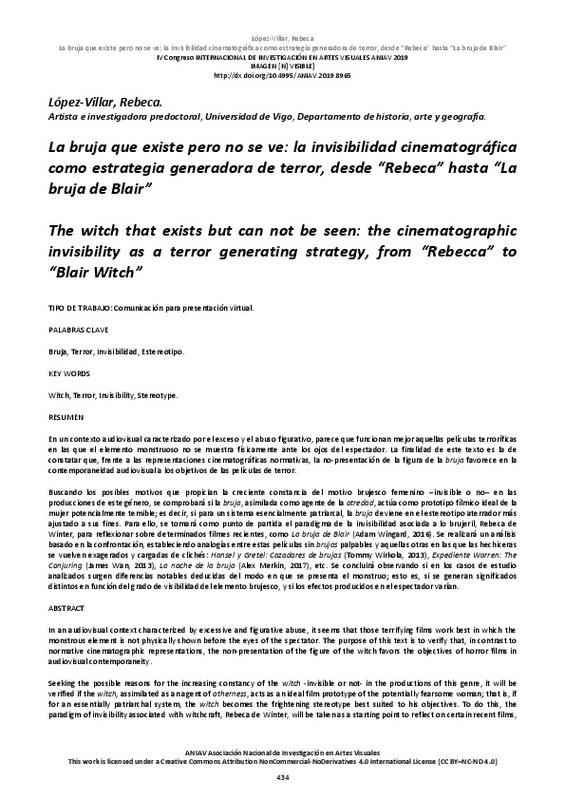|
Resumen:
|
[ES] En un contexto audiovisual caracterizado por el exceso y el abuso figurativo, parece que funcionan mejor aquellas películas terroríficas
en las que el elemento monstruoso no se muestra físicamente ante los ojos del ...[+]
[ES] En un contexto audiovisual caracterizado por el exceso y el abuso figurativo, parece que funcionan mejor aquellas películas terroríficas
en las que el elemento monstruoso no se muestra físicamente ante los ojos del espectador. La finalidad de este texto es la de
constatar que, frente a las representaciones cinematográficas normativas, la no-presentación de la figura de la bruja favorece en la
contemporaneidad audiovisual a los objetivos de las películas de terror.
Buscando los posibles motivos que propician la creciente constancia del motivo brujesco femenino –invisible o no– en las
producciones de este género, se comprobará si la bruja, asimilada como agente de la otredad, actúa como prototipo fílmico ideal de la
mujer potencialmente temible; es decir, si para un sistema esencialmente patriarcal, la bruja deviene en el estereotipo aterrador más
ajustado a sus fines. Para ello, se tomará como punto de partida el paradigma de la invisibilidad asociada a lo brujeril, Rebeca de
Winter, para reflexionar sobre determinados filmes recientes, como La bruja de Blair (Adam Wingard, 2016). Se realizará un análisis
basado en la confrontación, estableciendo analogías entre estas películas sin brujas palpables y aquellas otras en las que las hechiceras
se vuelven exagerados y cargadas de clichés: Hansel y Gretel: Cazadores de brujas (Tommy Wirkola, 2013), Expediente Warren: The
Conjuring (James Wan, 2013), La noche de la bruja (Alex Merkin, 2017), etc. Se concluirá observando si en los casos de estudio
analizados surgen diferencias notables deducidas del modo en que se presenta el monstruo; esto es, si se generan significados
distintos en función del grado de visibilidad del elemento brujesco, y si los efectos producidos en el espectador varían.
[-]
[EN] In an audiovisual context characterized by excessive and figurative abuse, it seems that those terrifying films work best in which the
monstrous element is not physically shown before the eyes of the spectator. The ...[+]
[EN] In an audiovisual context characterized by excessive and figurative abuse, it seems that those terrifying films work best in which the
monstrous element is not physically shown before the eyes of the spectator. The purpose of this text is to verify that, in contrast to
normative cinematographic representations, the non-presentation of the figure of the witch favors the objectives of horror films in
audiovisual contemporaneity.
Seeking the possible reasons for the increasing constancy of the witch -invisible or not- in the productions of this genre, it will be
verified if the witch, assimilated as an agent of otherness, acts as an ideal film prototype of the potentially fearsome woman; that is, if
for an essentially patriarchal system, the witch becomes the frightening stereotype best suited to his objectives. To do this, the
paradigm of invisibility associated with witchcraft, Rebeca de Winter, will be taken as a starting point to reflect on certain recent films, such as Blair Witch (Adam Wingard, 2016). An analysis based on confrontation will be made, establishing analogies between these
films without palpable witches and those in which the sorceresses become exaggerated and loaded with clichés: Hansel and Gretel:
Witch Hunters (Tommy Wirkola, 2013), The Conjuring (James Wan, 2013), House of the Witch (Alex Merkin, 2017), etc. It will conclude
by observing if in the analyzed study cases there are notable differences deduced from the way in which the monster appears; that is,
if different meanings are generated depending on the degree of visibility of the witch, and if the effects produced in the viewer vary.
[-]
|








